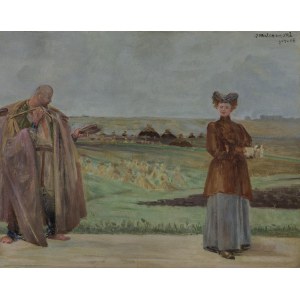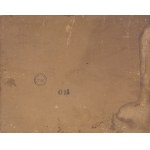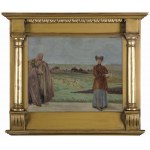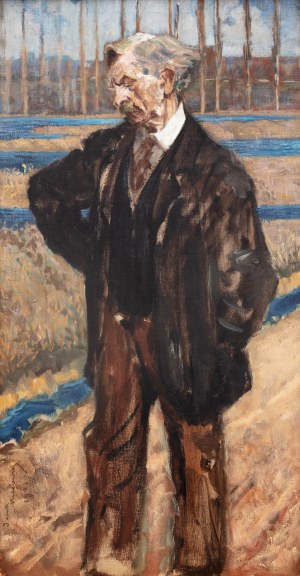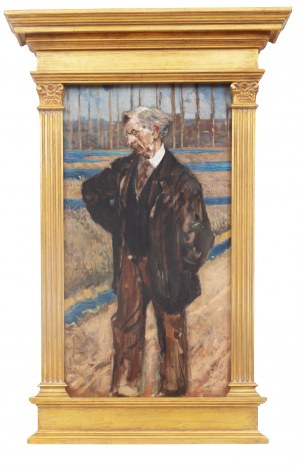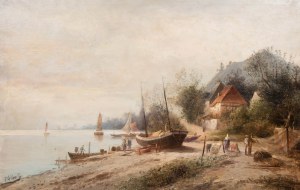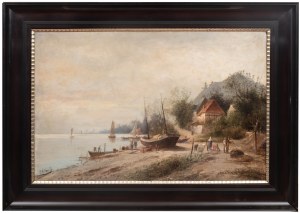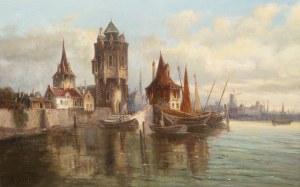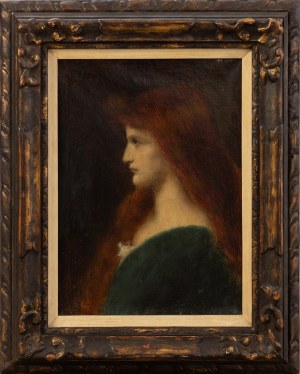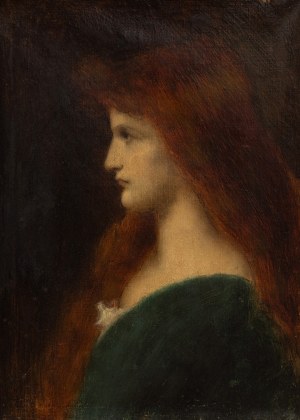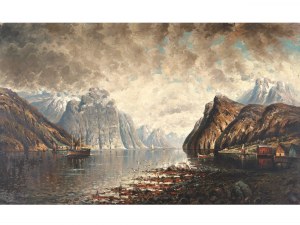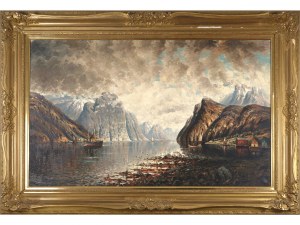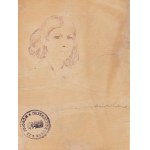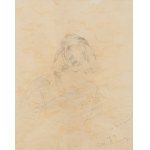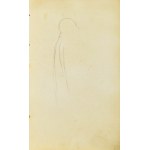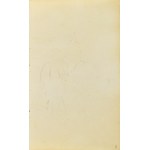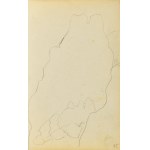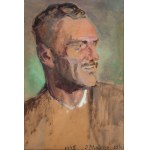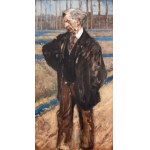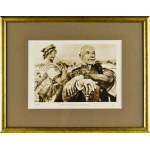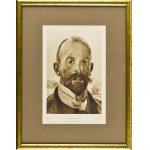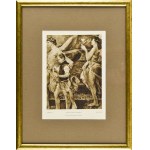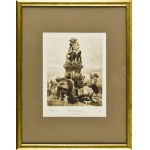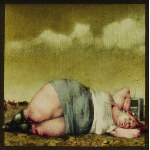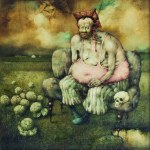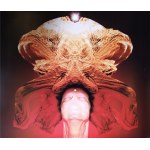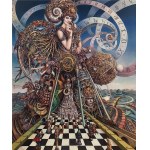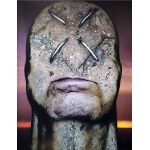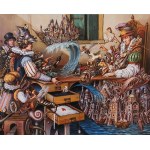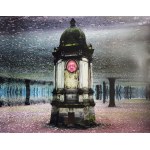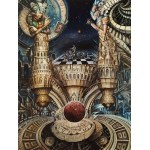32.5 x 40.6 cm - oil, cardboard signed p.g.: J Malczewski | 904-05
On the reverse, centrally, very faintly legible, stamp of the storehouse of painting utensils - the company "Lefranc et Cie": anchor crossed with a caduceus between the letters L F; next to it stamp with the number 110; moreover, round stamp with the Tarnawa coat of arms and an inscription in the rim: ZE ZBIORÓW | MARIA MALCZEWSKA; next to it an illegible stamp, probably of some Cracow company offering painting materials.
Toward Hope is a depiction of three equal characters. The central part is occupied by a truly Polish landscape. On the left we see the painter himself, and on the right is Maria Balowa - the most important woman and love of the artist's life. With this treatment, the artist made the landscape one of the protagonists of this work, putting it on a par with the surrounding figures and linking it in a close relationship with them.
At first glance, we are dealing with two people against a landscape, but it only takes a little concentration to see something more, and even much more. In the first moment we see a man, restrained by shackles and a chain. Stretching out a cap in his left hand - like a beggar - toward the woman facing him. The woman, who is getting ready to set out, is just putting on her glove and just turning her head toward the beggar. What kind of alms does he expect from her?
A material one? We know that Maria Balowa often hosted the painter at her estate and supported him financially. It was thanks to her that he could focus on creating great things - on Art.
Love? This time the artist handed Balowa, very inconspicuous at first glance, an attribute. The woman is improving, or perhaps just fastening a white glove. This item of clothing is not without a hidden meaning. In the case of lovers, the glove is the hand of love, and its white color may refer to the purity of this great feeling.
Or perhaps the artist is asking for inspiration? Maria Balowa was an extremely intelligent, well-read woman fascinated by art. She was for Malczewski not only a companion for interesting disputes, a muse, but also a frequent model. It is therefore possible that he turns to her asking for further inspiration.
The summer landscape accompanying the lovers shows bound sheaves waiting to be harvested. The grain is a symbol of life, fertility, abundance and God's blessing. In this way, the painter probably wanted to further emphasize and summarize their mutual relationship having a huge influence on his work.
We see another layer of symbolism contained in the painting by looking at the artist holding up the coat weighing down on his shoulders with his right hand. This is a chinchilla - a military Russian coat, in which he usually dressed Siberian deportees. In the artist's paintings, it always symbolized the experience of life's wanderings and the wandering of the former 1863 insurgents sentenced to Siberian exile. Malczewski felt he was an heir to Romantic traditions, and drew inspiration especially from the works of Juliusz Słowacki. In the painting on display, he depicted himself as a martyr ready to take up the challenge of history. Dressed in a chinchilla, he represents the old generation, which, shackled by shackles, longs for freedom and a return to the warmth of home.
However, the artist stands apart, as if unsure which way he should go. Should he go after the love of his life, or, like Anhelli, set out in the opposite direction, on a lonely journey for the salvation of the Nation. Or will he be able to convince his lover to embark on this journey with him? She is almost ready, she just needs to fasten her glove. She may even become his guide - the Shaman.
In his works, Malczewski repeatedly repeats the motif of a wanderer who, weary of wandering the world, longs to return to his homeland. In the painting presented here, he depicted himself as a martyr ready to take up the challenge of history. Here it should also be mentioned that after 1900 Jacek Malczewski repeatedly referred to the story of Tobias in his paintings. He created works both fully dedicated to scenes from the biblical story, and used only fragments of it - as a backdrop or supplement to the theme of the wanderer. In the presented painting, we can also see the addition of content to this very theme. An important motif of the story of old Tobias is undeserved suffering, which in Malczewski's work refers both to the suffering of the individual and the entire nation. Malczewski - like Anhelli - considered himself a martyr suffering for the freedom of the Fatherland. Covered in a heavy chinel, his legs are tied with a chain, and shackles can be seen on his wrists. This greatly slows down his journey. The hope, therefore, is the young Tobiah - the young generation who will reach maturity during his wandering. He will overcome the difficult road, full of temptations and pitfalls, and return to his old father to cure him of his blindness - to remove his shackles and give him freedom in the last years of his life. Malczewski hopes that the youngsters on the road will gain the courage and experience to face the biggest problems they will face in the future.
The landscape, showing bound sheaves of grain just waiting to be harvested, also refers to the hope for freedom. The artist, known for his love of his native land, repeatedly paid homage to it. He was one of those people who felt comfortable among nature and greatly respected it. Malczewski felt he was a representative of the old generation, which had already done its work, to the best of its ability. They had sown the grain (begotten descendants), tended it (preserved Polish speech and culture despite enslavement) and when it was fully ripe to give rise to new life, prepared it for harvesting. Now it's all in the hands of their successors - it's they who, like young Tobias, must embark on the difficult journey and reap the harvest. The artist is full of hope that, with God's blessing, after the harvest he will return to the bosom of the free Fatherland.
So, this at first inconspicuous, self-portrait with Maria Balowa against a landscape background is in fact a unique work, full of symbols and hope, containing everything that was most important in Jacek Malczewski's life and work.
Jacek Malczewski (Radom 1854 - Krakow 1929) - a prominent representative of Polish modernism painting, began his artistic studies at the School of Fine Arts in Krakow, where in 1872-1875 he studied under Feliks Szynalewski, Władysław Łuszczkiewicz and Jan Matejko, whose studio he attended again in 1877-1879. He then studied at the Paris École des Beaux Arts under E. Lehmann (1876-1877).
In 1880, he traveled to Italy. In 1884-1885, he took part - as a draughtsman - in Karol Lanckoroński's scientific expedition to Pamphylia and Pisidia in Little Asia. At that time he was also in Greece and Italy. In 1885-1886 he stayed in Munich for several months. Upon his return, he settled permanently in Cracow, from where he made further trips to Munich and Italy. In 1896-1900 he taught at the School of Fine Arts in Cracow, and from 1911-1922 he was a professor and twice rector of the Cracow Academy. He spent the years 1914-1915 in Vienna, and in 1916 returned to Cracow. In the last years of his life he stayed mainly in Luslawice and Charzewice near Zakliczyn. He was a co-founder of the Society of Polish Artists "Art" (1897) and a member of the "Zero" group (1908).
In his early period, he painted portraits, genre scenes and - above all - paintings with themes related to the martyrdom of Poles after the January Uprising (Death of Ellenai, Sunday in the Mine, On the Stage, Christmas Eve in Siberia). Later, from the 1890s, he created paintings of symbolic content with intermingled patriotic, biblical, fairy-tale, literary and allegorical-fantastic themes.
Recently viewed
Please log in to see lots list
Favourites
Please log in to see lots list



